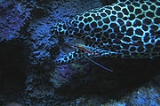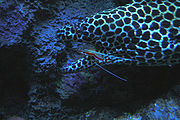
Cleaner shrimp
Encyclopedia
Cleaner shrimp is a generic term for any swimming decapod
crustacean
that cleans other organisms of parasites. This is a widely-cited example of symbiosis
: a relationship in which both parties benefit. The fish benefit by having parasites removed from them, and the shrimp gain the nutritional value of the parasites. In many coral reef
s, cleaner shrimp congregate at cleaning station
s.
In this behaviour cleaner shrimps resemble cleaner fish
, and sometimes actually may be seen to join cleaner wrasse
and other cleaner fish attending to client fishes.
 Cleaner shrimp may belong to any of three families
Cleaner shrimp may belong to any of three families
, Palaemonidae
(including the spotted cleaner shrimp
, Periclimenes yucatanicus and Periclimenes magnificus
), Hippolytidae
(including the Pacific cleaner shrimp
, Lysmata amboinensis) and Stenopodidae (including the banded coral shrimp
, Stenopus hispidus) . The last of these families is more closely related to lobster
s and crab
s than it is to the remaining families. The term "cleaner shrimp" is sometimes used more specifically for the family Hippolytidae and the genus Lysmata
.
Cleaner shrimp are often included in salt water
aquaria
to keep the tank clean.
Decapoda
The decapods or Decapoda are an order of crustaceans within the class Malacostraca, including many familiar groups, such as crayfish, crabs, lobsters, prawns and shrimp. Most decapods are scavengers. It is estimated that the order contains nearly 15,000 species in around 2,700 genera, with...
crustacean
Crustacean
Crustaceans form a very large group of arthropods, usually treated as a subphylum, which includes such familiar animals as crabs, lobsters, crayfish, shrimp, krill and barnacles. The 50,000 described species range in size from Stygotantulus stocki at , to the Japanese spider crab with a leg span...
that cleans other organisms of parasites. This is a widely-cited example of symbiosis
Symbiosis
Symbiosis is close and often long-term interaction between different biological species. In 1877 Bennett used the word symbiosis to describe the mutualistic relationship in lichens...
: a relationship in which both parties benefit. The fish benefit by having parasites removed from them, and the shrimp gain the nutritional value of the parasites. In many coral reef
Coral reef
Coral reefs are underwater structures made from calcium carbonate secreted by corals. Coral reefs are colonies of tiny living animals found in marine waters that contain few nutrients. Most coral reefs are built from stony corals, which in turn consist of polyps that cluster in groups. The polyps...
s, cleaner shrimp congregate at cleaning station
Cleaning station
A cleaning station is a location where fish, sea turtles, hippo and other aquatic life, freshwater and marine, congregate to be cleaned.The cleaning process includes the removal of parasites from the animal's body , and can be performed by various creatures A cleaning station is a location where...
s.
In this behaviour cleaner shrimps resemble cleaner fish
Cleaner fish
Cleaner fish are fish that provide a service to other fish species by removing dead skin and ectoparasites. This is an example of mutualism, an ecological interaction that benefits both parties involved. A wide variety of fishes have been observed to display cleaning behaviors including wrasses,...
, and sometimes actually may be seen to join cleaner wrasse
Wrasse
The wrasses are a family, Labridae, of marine fish, many of which are brightly colored. The family is large and diverse, with over 600 species in 82 genera, which are divided into nine subgroups or tribes....
and other cleaner fish attending to client fishes.

Family (biology)
In biological classification, family is* a taxonomic rank. Other well-known ranks are life, domain, kingdom, phylum, class, order, genus, and species, with family fitting between order and genus. As for the other well-known ranks, there is the option of an immediately lower rank, indicated by the...
, Palaemonidae
Palaemonidae
Palaemonidae is a family of crustaceans of the order Decapoda. They belong to the infraorder Caridea, which contains the true shrimp; while some freshwater palaemonid species are known as "prawns", the family belongs to the suborder Pleocyemata like all true shrimp, whereas the true prawns are...
(including the spotted cleaner shrimp
Spotted cleaner shrimp
The spotted cleaner shrimp , is a kind of cleaner shrimp common to the Caribbean Sea. These shrimp live in sea anemones, including Bartholomea annulata, Condylactis gigantea, Lebrunia danae and Rhodactis sanctithomae. They sway their body and wave their antennae in order to attract fish from which...
, Periclimenes yucatanicus and Periclimenes magnificus
Periclimenes magnificus
Ancylomenes magnificus, is a kind of cleaner shrimp common to the Western Pacific Ocean at depths of .These shrimp are commonly found on scleractinian coral, Catalaphyllia and the anemone, Dofleinia armata....
), Hippolytidae
Hippolytidae
Hippolytidae is a family of cleaner shrimp, also known as broken-back shrimp or anemone shrimp. The term "broken-back shrimp" also applies to the genus Hippolyte in particular and "cleaner shrimp" is sometimes applied exclusively to Lysmata amboinensis.-Genera:There are 36 recognised genera in the...
(including the Pacific cleaner shrimp
Pacific cleaner shrimp
Lysmata amboinensis, the northern cleaner shrimp, scarlet cleaner shrimp, skunk cleaner shrimp or Pacific cleaner shrimp, is an omnivorous shrimp species, which will generally scavenge and eat parasites and dead tissue. L...
, Lysmata amboinensis) and Stenopodidae (including the banded coral shrimp
Stenopus hispidus
Stenopus hispidus is a shrimp-like decapod crustacean belonging to the infraorder Stenopodidea. Common names include banded coral shrimp and banded cleaner shrimp.-Distribution:...
, Stenopus hispidus) . The last of these families is more closely related to lobster
Lobster
Clawed lobsters comprise a family of large marine crustaceans. Highly prized as seafood, lobsters are economically important, and are often one of the most profitable commodities in coastal areas they populate.Though several groups of crustaceans are known as lobsters, the clawed lobsters are most...
s and crab
Crab
True crabs are decapod crustaceans of the infraorder Brachyura, which typically have a very short projecting "tail" , or where the reduced abdomen is entirely hidden under the thorax...
s than it is to the remaining families. The term "cleaner shrimp" is sometimes used more specifically for the family Hippolytidae and the genus Lysmata
Lysmata
Lysmata is a genus of cleaner shrimp, containing the following species:*Lysmata amboinensis *Lysmata anchisteus Chace, 1972*Lysmata ankeri Rhyne & Lin, 2006*Lysmata argentopunctata Wicksten, 2000...
.
Cleaner shrimp are often included in salt water
Seawater
Seawater is water from a sea or ocean. On average, seawater in the world's oceans has a salinity of about 3.5% . This means that every kilogram of seawater has approximately of dissolved salts . The average density of seawater at the ocean surface is 1.025 g/ml...
aquaria
Aquarium
An aquarium is a vivarium consisting of at least one transparent side in which water-dwelling plants or animals are kept. Fishkeepers use aquaria to keep fish, invertebrates, amphibians, marine mammals, turtles, and aquatic plants...
to keep the tank clean.

